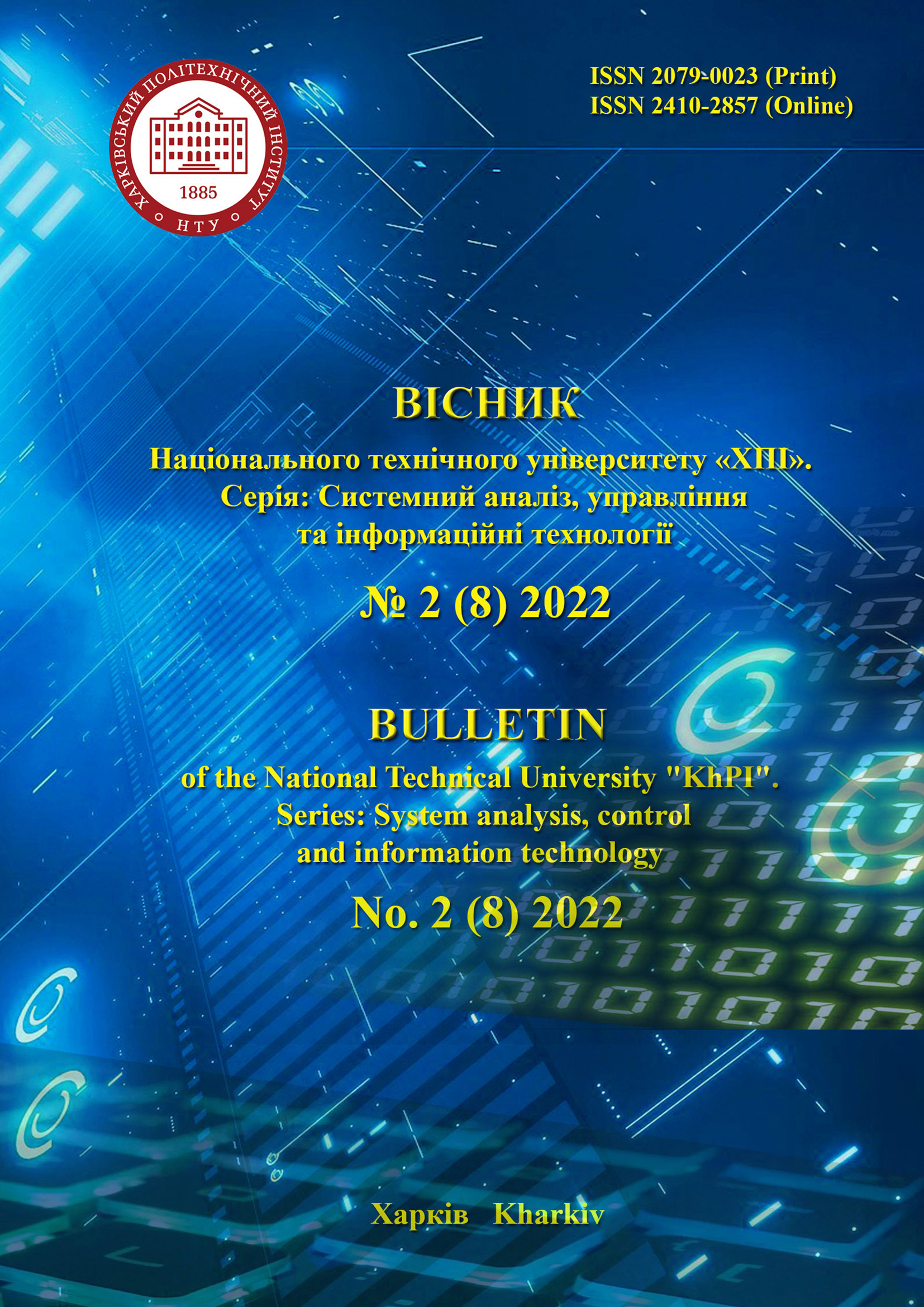CONSTRUCTION OF MULTI-CRITERIA SOLUTIONS TO SELECTION PROBLEMS
DOI:
https://doi.org/10.20998/2079-0023.2022.02.06Keywords:
selection problems, criteria, multi-criteria selection, construction of decisions, method of concessions, decision-making subsystemsAbstract
An approach to solving the problems of multi-criteria selection with the determination of suitable applicants based on the values of a number of criteria is considered. Known approaches to the solution of these problems do not always allow determining reasonable solutions with full consideration of the features of the selected criteria and their evaluation conditions. Comparison of evaluations by criteria often takes place from subjective positions without proper justification, which affects both the results of the selection and the possibilities of their practical application. Known multi-criteria selection procedures use fixed measurement scales to compare values, which in practical situations may not correspond to real ratios of indicators. Another significant shortcoming of these procedures is ignoring the presence of non-linear dependencies between evaluations by criteria and attributes of decisions made in different ranges of their values. The above indicates the possibility of obtaining inadequate evaluations of decisions with corresponding negative consequences. The paper proposes an approach to the construction of solutions to multi-criteria selection problems based on the definition of applicants by ordering them according to the degree of approximation to the option with the best ratios of evaluations according to the selected performance criteria based on iterative concessions according to the specified criteria. Applicants are compared on the basis of the ratios of assessments according to the agreed criteria, the definition of which is provided by a set of mathematical models that reproduce the dependence of the values of individual criteria on the attributes of the applicant decisions. The formation of a sequence of candidates for solutions is based on the results of comparisons according to individual criteria, which allows to determine alternative solutions and evaluate their effectiveness with the construction of a Pareto subset. An example is considered that reproduces the processes of choosing alternative options for building a virtual data processing system based on the characteristics of virtual machines from providers of cloud processing technologies. The obtained research results indicate the possibility of using the proposed approach as part of decision-making support subsystems to solve the problems of operational management of dynamic service and production processes.
References
Saaty T. L. A scaling method for priorities in hierarchical structures. Journal of Mathematical Psychology. 1977, vol. 15, no 3, pp. 234–281.
Saaty T. L. Decision making with the analytic hierarchy process. International Journal of Services Sciences. 2008, vol. 1, no 1, pp. 83–98.
Saaty T. L., Shang J. An innovative ordersof-magnitude approach to AHP-based mutli-criteria decision making: Prioritizing divergent intangible humane acts. European Journal of Operational Research. 2011, vol. 214, no. 3, pp. 703–715.
Vartanian V. M., Shteinbrekher D. O. Zastosuvannia metodu analizu iierarkhii dlia pobudovy stratehii upravlinnia znanniamy vysokotekhnolohichnykh proektiv [Application of the hierarchy analysis method for building a knowledge management strategy for high-tech projects]. Radioelektronni i kompiuterni systemy [Radioelectronic and computer systems]. 2019, no. 2(90), pp. 118–126.
Danilova I. S., Bukrieiev V. Iu. Zastosuvannia metodu analizu iierarkhii dlia pryiniattia upravlinskykh rishen v zovnishnoekonomichnii diialnosti [Application of the method of analysis of hierarchies for making management decisions in foreign economic activities]. Skhidna Yevropa: ekonomika, biznes ta upravlinnia [Eastern Europe: Economy, Business and Management]. 2018, is. 6 (17), pp. 167–172.
Ippolitova I. Ia., Sorokotiazhenko K. S. Vykorystannia metodu analizu iierarkhii pid chas realizatsii stratehii enerhozberezhennia [Using the method of analyzing hierarchies during the implementation of the energy saving strategy]. Hlobalni ta natsionalni problemy ekonomiky [Hlobalni ta natsionalni problemy ekonomiky]. 2016, is. 14, pp. 370–376.
Ayhana M. B. Fuzzy AHP Approach for supplier selection problem: a case study in a gearmotor company. International Journal of Managing Value and Supply Chains (IJMVSC). 2013, vol. 4, no. 3, pp. 11–23.
Solangi Y. A. Assessing and overcoming the renewable energy barriers for sustainable development in Pakistan: An integrated AHP and fuzzy TOPSIS approach. Renewable Energy. 2021, vol. 173, pp. 209–222.
Zhang H. The Analysis of the Reasonable Structure of Water Conservancy Investment of Capital Construction in China by AHP Method. Water Resources Management. 2009, vol. 23, pp. 1–18.
Kandyba I. O. Bahatokryterialnyi vybir krashchoho stsenariiu vstupnoi kampanii zakladu vyshchoi osvity [Multi-criteria selection of the best scenario for the entrance campaign of a higher education institution]. Informatyka, obchysliuvalna tekhnika ta avtomatyzatsiia [Informatics, computing and automation]. 2021, vol. 32(71), no. 4, pp. 71–77.
Ivchenko R. A., Kupin A. I. Doslidzhennia metodiv bahatokryterialnoi optymizatsii dlia vyboru obladnannia abo detalei na vyrobnytstvi [Study of multi-criteria optimization methods for selecting equipment or parts in production.]. Informatyka, obchysliuvalna tekhnika ta avtomatyzatsiia [Informatics, computing and automation]. 2021, vol. 32 (71), part. 1, no. 1, pp. 67–72.
Podinovski V. V. Potential optimality in multicriterial optimization. Computational Mathematics and Mathematical Physics, 2014, vol. 54, pp. 429–438.
Nelyubin A. P., Podinovski V. V. Multicriteria choice based on criteria importance methods with uncertain preference information. Computational Mathematics and Mathematical Physics, 2017, vol. 57, pp. 1475–1483.
LINDO® Software for Integer Programming, Linear Programming, Nonlinear Programming, Stochastic Programming, Global Optimization. Available at: https://www.lindo.com/ (accessed: 15.05.2022).
Downloads
Published
How to Cite
Issue
Section
License
LicenseAuthors who publish with this journal agree to the following terms:
- Authors retain copyright and grant the journal right of first publication with the work simultaneously licensed under a Creative Commons Attribution License that allows others to share the work with an acknowledgement of the work's authorship and initial publication in this journal.
- Authors are able to enter into separate, additional contractual arrangements for the non-exclusive distribution of the journal's published version of the work (e.g., post it to an institutional repository or publish it in a book), with an acknowledgement of its initial publication in this journal.
- Authors are permitted and encouraged to post their work online (e.g., in institutional repositories or on their website) prior to and during the submission process, as it can lead to productive exchanges, as well as earlier and greater citation of published work (See The Effect of Open Access).


